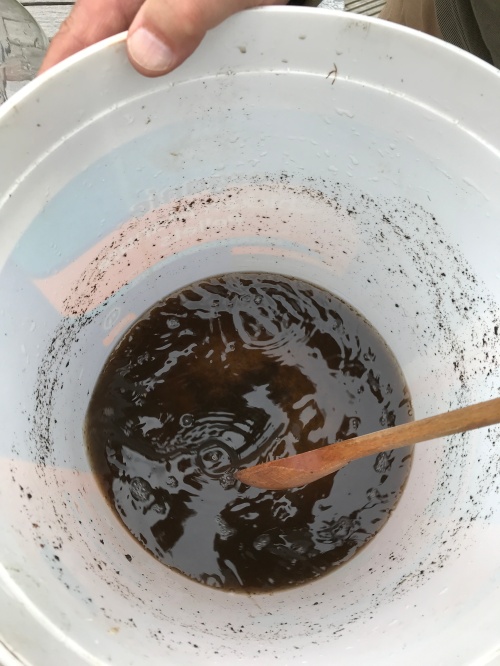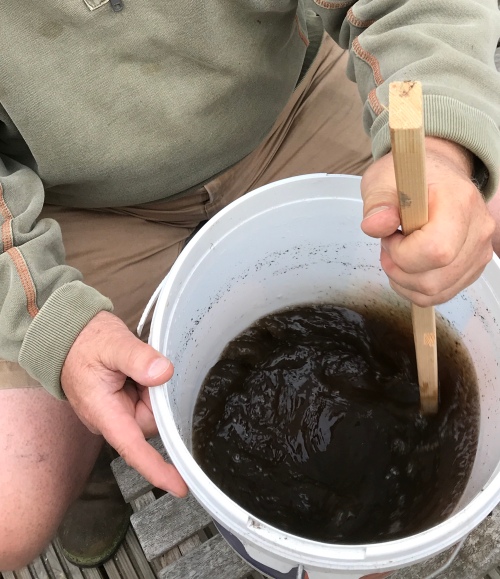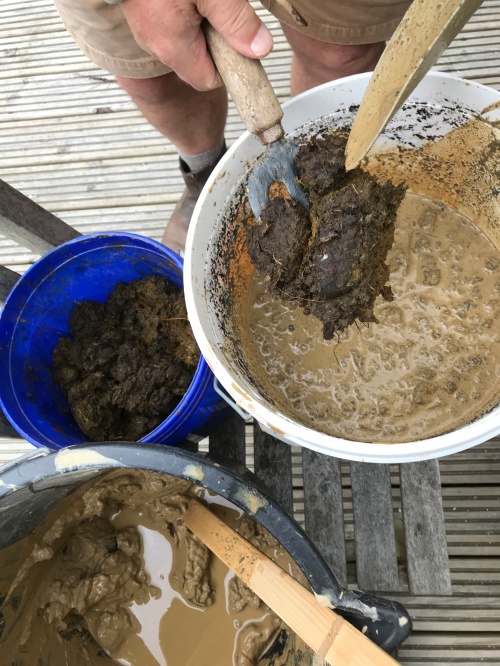I’ve said it before but I think it bears repeating: if biodynamic agriculture and horticulture are ever to become mainstream, then the first signs of this are going to be in the world of fine wines. We are already seeing evidence of this: Monty Waldin, a wine writer and biodynamic specialist, estimates that in 2017 about 5 per cent of the world’s vineyards were certified organic or biodynamic. In 1999 it was less than 1 per cent.
Something is clearly going on, because biodynamic viticulture has just been the subject of an entire column by the eminent wine writer and Master of Wine, Jancis Robinson, in the Financial Times Weekend Magazine of September 29/30th 2018. If the FT is sitting up and taking notice of biodynamic wines, then this is an indication of a significant shift in culture among the monied classes; and where they go, mainstream culture will surely follow.
True, Robinson shows no real understanding of biodynamics in her column and a sarcastic sub-editor gave it the headline “Hogwarts school of viticulture.” But she does appreciate some of the reasons why people might be wary of conventional viticulture: “Anyone who has visited a wine region and seen vineyard workers spraying chemicals so potent that they are clad as if they were investigating a Novichok incident is likely to find organically grown grapes an attractive proposition”. She goes on to say:
“The principles of biodynamics were outlined by the philosopher Rudolf Steiner in the 1920s. Many of them seem barmy. The emphasis on soil health, as in organics, is surely sensible. The postwar period of technological revolution coupled with the imperative of quantity over quality left a legacy of heavily compacted soils deprived of nutrients, organic matter and microbes. Healthy soil encourages healthy plants and I have often found extra vitality in wines that turned out to be biodynamic.
Steiner’s insistence that a farm should be a holistic ecosystem rather than a commercially efficient monoculture is a much further step away from conventional science, but has resulted in a dramatic increase in fauna to be found on the land of biodynamic practitioners.
But it is the third tenet of biodynamics that is most controversial and the reason why many rationalists dismiss it as ‘pseudoscience’. Full embrace of biodynamism involves the application of homeopathic doses of preparations based on the likes of quartz powder, camomile and nettles. Some are supposed to be buried in cow horns or other animal parts. All are supposed to be applied, and vineyard operations conducted, according to the celestial calendar.
This is the part only the most devoted biodynamic practitioners adhere to, but they assure non-believers that these can transmit energy and health to the soil, vines and grapes. Sceptical scientists point to the weakness of lunar forces. But even non-biodynamic wine producers have long been careful to time their bottling with the phases of the moon to ensure their wines are star-bright”.
Well, you can tell from all of this that Jancis Robinson is some way from any real appreciation of or insights into biodynamics – but it’s a start and it should be applauded. She goes on to list some of the starry vineyards that have adopted biodynamic viticulture – too many to list here, I’m glad to say – but they include the very best of French producers, including chateaux in Bordeaux, Burgundy, Rhone, Champagne and Alsace, as well as wine growers in Italy, Spain, Germany, Austria, California, Washington, Chile, Argentina, Australia and New Zealand. (There are also at least three biodynamic vineyards in the UK.)
But her column got me thinking: if the world is starting to wake up to biodynamics, is the biodynamic movement in a position to respond to meet increasing demand for knowledge, techniques and the supply of BD preparations?
This question has recently taken on a personal dimension for me. When we moved into our house in Forest Row in 2015, one of the things that attracted me to it was the garden and the possibility it gave of planting a small orchard, which is something I have wanted all my life. When I say a small orchard, I mean it: there are just fourteen fruit trees. But although it’s small, each variety was chosen very carefully, for flavour rather than yield and with pollination compatibility in mind where appropriate. There are four apple trees, three of them varieties from Sussex; three pears; one plum, one gage and one damson; one quince; one mulberry, a morello cherry and a fig. We’ve also got a soft fruit bed, with blackcurrants, redcurrants, gooseberries and blueberries (the last in large pots, so I can give them the acidic soil conditions they need).
It’s a sad fact but once you have planted your trees, you cannot just let them get on with growing. They are subject to attack from birds, animals and insects, plus all sorts of diseases and ailments – they still need your care and regular attention. Given all these problems and predations, I’m impressed that farmers and growers manage to provide us with anything to eat at all; and it’s no wonder that conventional horticulture has come up with many kinds of chemical cocktails to be sprayed at regular intervals to save some of our food and fruit from wildlife and diseases. But I’m one of those who likes to think that there is a better way of dealing with these issues and for me, organic and biodynamic are my preferred methods.
So when the gage tree, a 19thcentury variety called Early Transparent Gage and planted with loving care as a one-year old tree in our garden in December 2016, developed signs of bacterial canker on the trunk, I was devastated. There is no chemical remedy for this disease and all you can do is to cut out the signs of canker and put wound paint on the area – and since the canker is on a large area of the trunk of what is a young tree, the prognosis isn’t good. Following advice from the excellent Briony Young, who makes the biodynamic preparations at Tablehurst Farm, I decided to cut out what I could of the canker and apply biodynamic tree paste to the wounds.
It was at this point where my question occurred about the availability of biodynamic remedies. There is no possibility of going to a garden centre to buy a tin of tree paste. Anyone seeking to use this remedy needs to assemble some ingredients, not all of which are easy to source, and then go through a fairly elaborate and lengthy preparation process.
To describe it as briefly as possible, here’s what you do. First of all, source the ingredients:
- 1 part clay, mixed with a little rainwater and chopped up to achieve a smooth texture with no lumps
- 1 part fine sand (or diatomaceous earth)
- 1 part fresh cow manure
- 1 unit of horn manure 500
- Equisetum tea 508 made with rainwater
- A generous handful of cow pat pit preparation (CPP)
I was fortunate in being able to get all of these ingredients from Tablehurst Farm. Then you:
Make the equisetum tea with rainwater:

Use the tea to dissolve the horn manure and dynamise the liquid by stirring for 1 hour, creating and breaking vortices in the water:

Add the CPP for the last 20 minutes of stirring:

Pour the dynamised liquid into the bucket with the clay and then gradually stir in the fresh cow manure:

Gradually stir in the sand:

The finished tree paste should have the consistency of pancake mixture, sloppy enough to apply to tree trunks with a paintbrush. (Here it is being applied to an olive tree in a pot):

Well, quite apart from the difficulty of finding the ingredients, you can tell that all of this is a great deal of trouble and work, unlikely to be done by the average gardener. So why did my wife and I do it? It’s because as far as I know only biodynamic tree paste has the capacity to work on the bacterial canker and to heal the disease so that the tree can survive. The commercial tree wound paints are effective only if you can remove all of the canker and cut back to clean wood, which in the case of a young tree like our gage was not possible because of the extent and location of the canker.
I’ll let you know in a year or two whether the tree paste has done what we hoped for; and if it does, then I think there is a commercial opportunity for someone to make pre-prepared biodynamic tree paste widely available in garden centres for the general gardening public. If biodynamics is to become mainstream, then ways need to be found in which these wonderful preparations and the philosophy behind them can be made less “barmy” and more widely available to amateur gardeners and professional growers alike.

Meanwhile a lot of research has been done into this „pseudoscience and barmy methods“.
Juergen Fritz works at the University of Kassel, Germany, coordinating the teaching and research of bio-dynamic agriculture and gardening. Here you also find publications of research papers in English
https://www.uni-kassel.de/fb11agrar/en/sections/organic-farming-and-cropping-systems/staff/juergen-fritz.html
https://www.uni-kassel.de/fb11agrar/en/sections/organic-farming-and-cropping-systems/research.html
https://www.uni-kassel.de/fb11agrar/en/sections/organic-farming-and-cropping-systems/research.html
Otto
LikeLike
Thanks for this though-provoking post and the great tutorial on making the BD tree paste. Serious wine drinkers often have very sensitive palates and their senses tell them what is good, and they are willing to pay for it. Also the
growing awareness of the need to care for the soil and the ecosystems on the farm or vineyard are an added reason why the increasingly “bio-literate” public are turning to organic or even BD products if they can find them.
Thanks also to Otto for the research link. Some interesting work going on around the world.
worth checking out the following blog too. https://biodynamicsbda.wordpress.com/
As with the wines, I think people will go for BD-type medicines and preparations for their farms and gardens if there is some tangible evidence that they work, and they, or the related ingredients are available. Trusted opinion-formers such as Prince Charles, or demonstration farms can play a role here, as can well-presented and interesting blogs that give people the confidence to give it a try.
Maybe Jeremy and other BD farmers around the world should keep video diaries showing how the remedies work (or not) over time and put them on line ?
LikeLike
Jeremy, it is always going to be of interest that Rudolf Steiner gave only one specific course on agricultural practice in relation to the science of the spirit. This he gave in early June of 1924.
https://wn.rsarchive.org/Lectures/GA327/English/BDA1958/Ag1958_index.html
Now, if he had lived until 1933, which is a reasonable date because he would have been 72 years old, and, as well, this would have also seen the advent of the Second Coming of Christ, it is only most likely that practical organic biodynamic gardening would have seen many further indications of how the soil of the earth could be improved, and likely caused a worldwide movement for renewing the earth as a sustainable entity in spite of those forces that would make it the weak entity that it is today.
But, leaving that aside just now, what is the significance of the blue gloves to apply the tree paste in order to cure the canker? I hope it is not ceremonial 🙂
That might be considered blasphemy from a truly spiritual scientific angle.
LikeLike
The blue gloves have no significance, other than that my wife has sensitive skin!
LikeLike
I’m seeing ‘Biodynamic’ on a couple of labels in one of the large supermarkets (Woolworths), here in Australia. Yoghurt is one item. That is heartening.
LikeLike
Dear Jeremy,
you said that „the world of wines“ would be the first place where bio-dynamic agriculture would become mainstream (or more modestly become more widely known and appreciated). Did you give reasons for your prediction then? (By the way, and it s no joke, in a French journal I once read that anthroposophy is best known for the bio-dyn wine. In Germany I think it would be the Waldorf school.)
I agree with you, Jeremy, and I think it is because in vine „quality, good taste“ is the first and most important criteria. And in vine tasting „quality“ is not translated into numbers, say calories, fat, vitamins, enzymes etc., it is „quality“ or taste „without numbers“.
If there were milk tasters, apple tasters etc. bio-dyn would get best marks as well, but in the milk industry and apple industry -and the word industry says it all!- quantity is what counts, not quality, not taste.
In many starred restaurants, bio-dyn vegetables are appreciated. But for the mainstream folks I think it will take a century until bio-dyn potatoes are recognized as being of superior quality.
Otto
LikeLike
Hi Jeremy,
what is your explanation or interpretation of the fact that there are so few comments on this topic? What does it tell us?
Otto
LikeLike
It’s probably because this topic is largely a descriptive account of the making of tree paste and as such doesn’t offer much scope for speculation or additional explanations.
LikeLike
How is your olive tree now, some time after you applied the tree paste?
LikeLike
Hello Mila,
Thanks for asking! It wasn’t the olive tree (as in the picture) that was in trouble but a plum (gage)tree, which had bacterial canker on the main trunk. I’ve just given the gage a second coat of tree paste but I don’t think results will be visible until next summer. I’ll let you know how it turns out.
Best wishes,
Jeremy
LikeLike